

Could Amsterdam's New Economic Theory Replace Capitalism? One evening in December, after a long day working from home, Jennifer Drouin, 30, headed out to buy groceries in central Amsterdam.
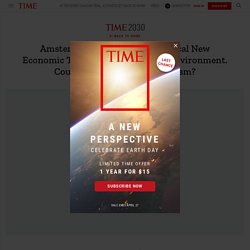
Once inside, she noticed new price tags. The label by the zucchini said they cost a little more than normal: 6¢ extra per kilo for their carbon footprint, 5¢ for the toll the farming takes on the land, and 4¢ to fairly pay workers. A healthy economy should be designed to thrive, not grow. Amsterdam is now using the "doughnut" model of economics. A healthy economy should be designed to thrive, not grow. "Arbetssamhället gör oss till slavar" - Roland Paulsen. (1) Luka Trkanjec's answer to How did the concept of money actually emerge from the 'barter system'? The IMF Confirms That 'Trickle-Down' Economics Is, Indeed, a Joke. "Trickle-down" economics began as a joke. Seriously. If there’s one person most often associated with the origins of of trickle-down economics, it’s President Ronald Reagan. Few people know, however, that the phrase was actually coined by American humorist Will Rogers, who mocked President Herbert Hoover’s Depression-era recovery efforts, saying that "money was all appropriated for the top in the hopes it would trickle down to the needy.
" Rogers’ joke became economic dogma within two generations, thanks in large part to Reagan. At the center of Reagan’s economic doctrine was the idea that economic gains primarily benefiting the wealthy—investors, businesses, entrepreneurs, and the like—will "trickle-down" to poorer members of society, creating new opportunities for the economically disadvantaged to attain a better standard of living. Increasing the income share to the bottom 20 percent of citizens by a mere one percent results in a 0.38 percentage point jump in GDP growth.
Economics 101 and Ecological Collapse. Via the Economics of Happiness Blog.
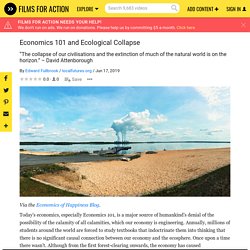
Today’s economics, especially Economics 101, is a major source of humankind’s denial of the possibility of the calamity of all calamities, which our economy is engineering. Annually, millions of students around the world are forced to study textbooks that indoctrinate them into thinking that there is no significant causal connection between our economy and the ecosphere. Once upon a time there wasn’t. The Economic Lessons of Star Trek’s Money-Free Society.
A few years ago Manu Saadia, a longtime Star Trek fan, went looking for a book about the economics of Star Trek.
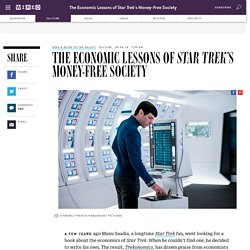
When he couldn’t find one, he decided to write his own. The result, Trekonomics, has drawn praise from economists such as Brad DeLong and Joshua Gans. Saadia says that Star Trek is one of the few science fiction universes that grapple with the idea that money may someday become obsolete. Podcast Audio Player. Thoughts? - Mind Unleashed Art. Artificial Intelligence and the Circular Economy. This paper provides an initial exploration of the intersection of two emerging megatrends: artificial intelligence and the circular economy.
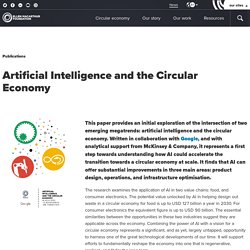
Written in collaboration with Google, and with analytical support from McKinsey & Company, it represents a first step towards understanding how AI could accelerate the transition towards a circular economy at scale. It finds that AI can offer substantial improvements in three main areas: product design, operations, and infrastructure optimisation. The research examines the application of AI in two value chains: food, and consumer electronics. The potential value unlocked by AI in helping design out waste in a circular economy for food is up to USD 127 billion a year in 2030.
For consumer electronics the equivalent figure is up to USD 90 billion. Guy Verhofstadt - Numbers speak louder than words. This... Infographic Of The Day: The 80 Trillion World Economy In One Chart. Posted on 14 November 2018 The latest estimate from the World Bank puts global GDP at roughly $80 trillion in nominal terms for 2017.
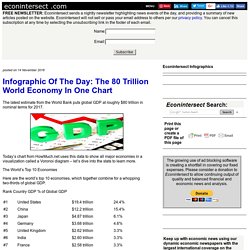
Today’s chart from HowMuch.net uses this data to show all major economies in a visualization called a Voronoi diagram – let’s dive into the stats to learn more. The World’s Top 10 Economies Here are the world’s top 10 economies, which together combine for a whopping two-thirds of global GDP. Rank Country GDP % of Global GDP In nominal terms, the U.S. still has the largest GDP at $19.4 trillion, making up 24.4% of the world economy. While China’s economy is far behind in nominal terms at $12.2 trillion, you may recall that the Chinese economy has been the world’s largest when adjusted for purchasing power parity (PPP) since 2016.
The next two largest economies are Japan ($4.9 trillion) and Germany ($4.6 trillion) – and when added to the U.S. and China, the top four economies combined account for over 50% of the world economy. How Amazon Became Corporate America’s Nightmare. Amazon makes no sense.
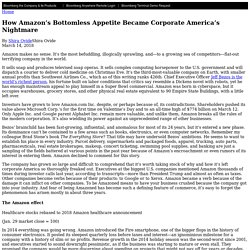
It’s the most befuddling, illogically sprawling, and—to a growing sea of competitors—flat-out terrifying company in the world. It sells soap and produces televised soap operas. It sells complex computing horsepower to the U.S. government and will dispatch a courier to deliver cold medicine on Christmas Eve. It’s the third-most-valuable company on Earth, with smaller annual profits than Southwest Airlines Co., which as of this writing ranks 426th. Chief Executive Officer Jeff Bezos is the world’s richest person, his fortune built on labor conditions that critics say resemble a Dickens novel with robots, yet he has enough mainstream appeal to play himself in a Super Bowl commercial. Investors have grown to love Amazon.com Inc. despite, or perhaps because of, its contradictions. Bill McDonough: We are here to make goods, not 'bads' The World Is Now $217,000,000,000,000 In Debt, And The Global Elite Like It That Way. (Michael Snyder) The borrower is the servant of the lender, and through the mechanism of government debt virtually the entire planet has become the servants of the global money changers.

Politicians love to borrow money, but over time government debt slowly but surely impoverishes a nation. As the elite get governments around the globe in increasing amounts of debt, those governments must raise taxes in order to keep servicing those debts. In the end, it is all about taking money from us and transferring it into government pockets, and then taking money from government pockets and transferring it into the hands of the elite.
It is a game that has been going on for generations, and it is time for humanity to say that enough is enough. According to the Institute of International Finance, global debt has now reached a new all-time record high of 217 trillion dollars… Artificial intelligence pioneer calls for the breakup of Big Tech - Axios. The big change: The GOP leaders and the White House plan to cut the top tax rate for small businesses — known as "pass-throughs" — from 39.6 percent to 25 percent.

(Currently small businesses pay the same tax rates as individuals, and this puts them at a disadvantage to larger corporations, which pay lower rates.) The so-called "Big Six" tax framework — named because it's been hashed out behind closed doors between six top Republicans and administration officials — will set up a clash with Democrats over the tax breaks that apply to large corporations and upper income Americans.
Most Democrats have already drawn a red line on tax reform: 45 out of 48 Democratic senators signed a letter saying they wouldn't support any tax bill that adds to the deficit or offers new tax breaks to the wealthiest Americans.But Republicans are desperate for a win and appear on course to fund tax cuts with a blend of deficit spending and the closing of loopholes. Top individual tax rate cut from 39.6 to 35. The World Is Now $217,000,000,000,000 In Debt, And The Global Elite Like It That Way. Support the creation of more videos like... - Sustainable Human. Richard Florida Is Sorry. Cervenka: De tio största hoten mot världsekonomin. Neoliberalism has hijacked our vocabulary. At a recent art exhibition I engaged in an interesting conversation with one of the young people employed by the gallery.

The Sharing Economy: Capitalism’s Last Stand? To Divide the Rent, Start With a Triangle. Last year, two friends and I moved into a small three-bedroom apartment in Manhattan.

We chose it for its relatively reasonable price — around $3,000 a month — and its convenient location. Just finding it was a challenge, but then we faced another one: deciding who would get each bedroom. The bedrooms were different sizes, ranging from small to very small. Two faced north toward the street and had light; the third and smallest faced an alley. The largest had two windows; the midsize room opened onto the fire escape. Every month, unrelated people move into apartments together to save on rent.